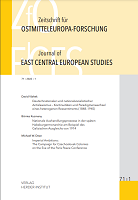Deutschnationaler und nationalsozialistischer Antislawismus – Kontinuitäten und Paradigmenwechsel eines heterogenen Ressentiments (1848–1945)
German Nationalist and National Socialist Antislavism –Continuities and Paradigm Changes of a Heterogeneous Animosity (1848-1945)
Author(s): David VlahekSubject(s): Political history, Nationalism Studies, 19th Century, Pre-WW I & WW I (1900 -1919), Interwar Period (1920 - 1939), WW II and following years (1940 - 1949)
Published by: Verlag Herder-Institut
Keywords: Antislavism; National Socialism; Eastern Europe, racism; nationalism;
Summary/Abstract: The article examines a relatively unknown and yet crucial animosity inherent to the nineteenth century German Nationalist and later National Socialist ideologies. It aims to identify the continuities and paradigm changes of Antislavic sentiment through this long and heterogeneous timespan, taking into account several different areas of Eastern Europe. For this purpose, various sources, such as newspapers, scientific writings, political speeches etc., have been analyzed. It is shown herein that German Nationalist Antislavism can be traced back to the “civilizing” discourse of the nlightenment and was further politicized through the nationalization of Europe during the nineteenth century, when German nationalists strongly accused their Slavic neighbors of being expansive but simultaneously primitive and unable to create a functioning state. The reason for the so-called Kulturgefälle was llegedly to be found in the inferiority of Slavic cultures and languages, and not in the biological blueprints of its people. However, German Antislavism began to rapidly change its paradigms at the end of the nineteenth century, when the biologist concepts of “race” and “blood” gradually entered the scientific and political spheres. The outcomes of World War I further radicalized the pre-existing Antislavism. It was appropriated by the rising National Socialists, who pushed it to a more perilous level with their ideas of racial purity and territorial expansion. The article explains the historical roots of the atrocities in Eastern Europe during World War II while at the same time also recognizing the ambiguity in, and the diversity of, Antislavism itself.
Journal: Zeitschrift für Ostmitteleuropa-Forschung
- Issue Year: 71/2022
- Issue No: 1
- Page Range: 1-38
- Page Count: 38
- Language: German

